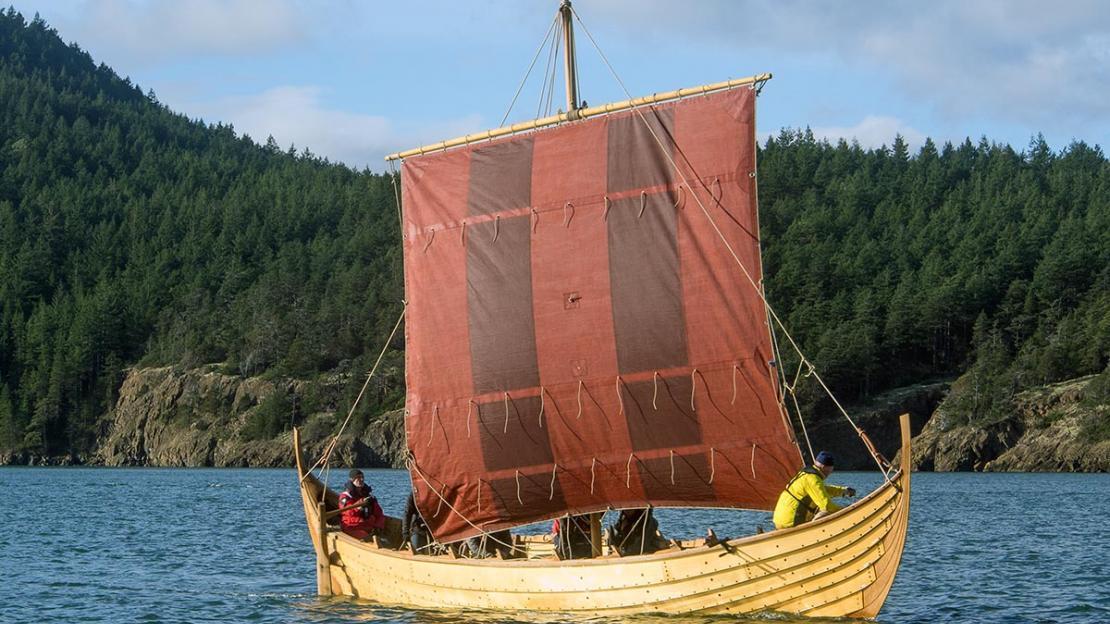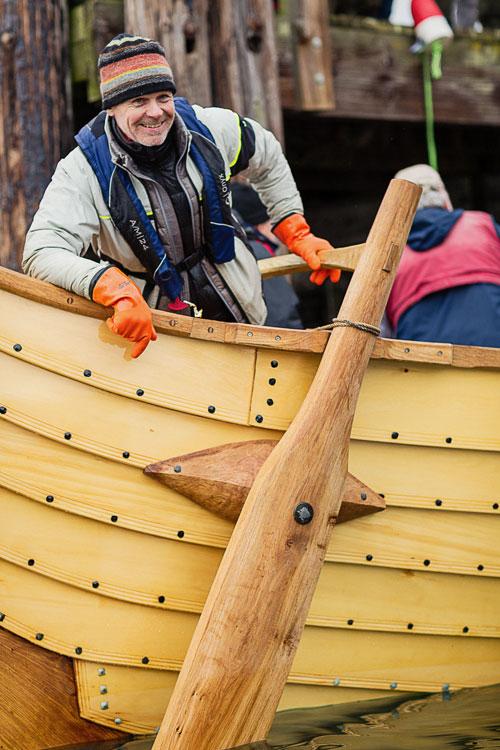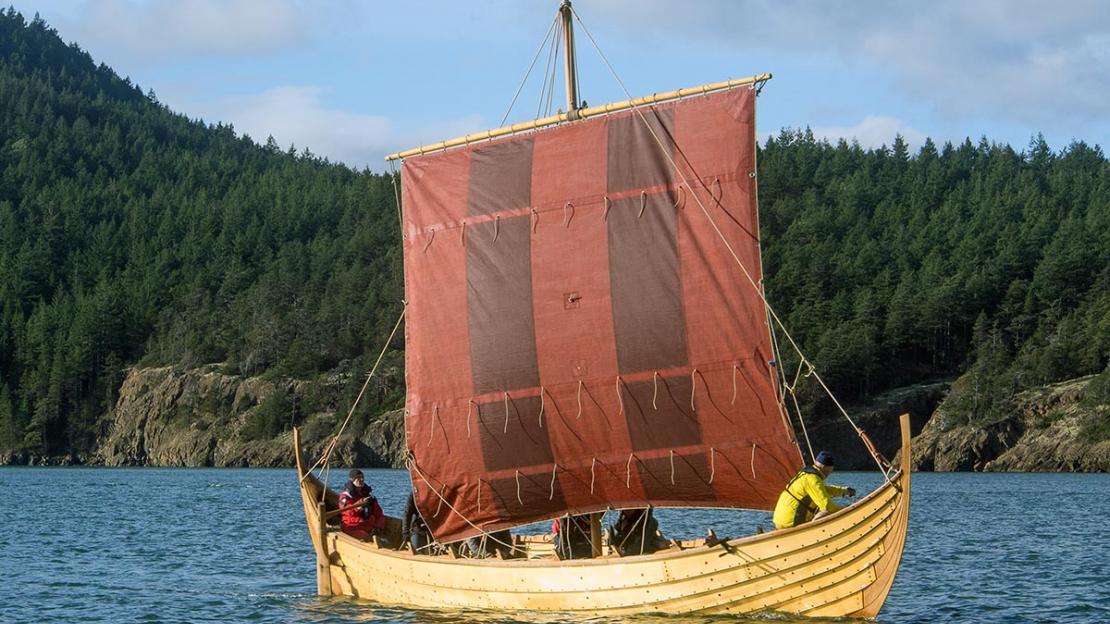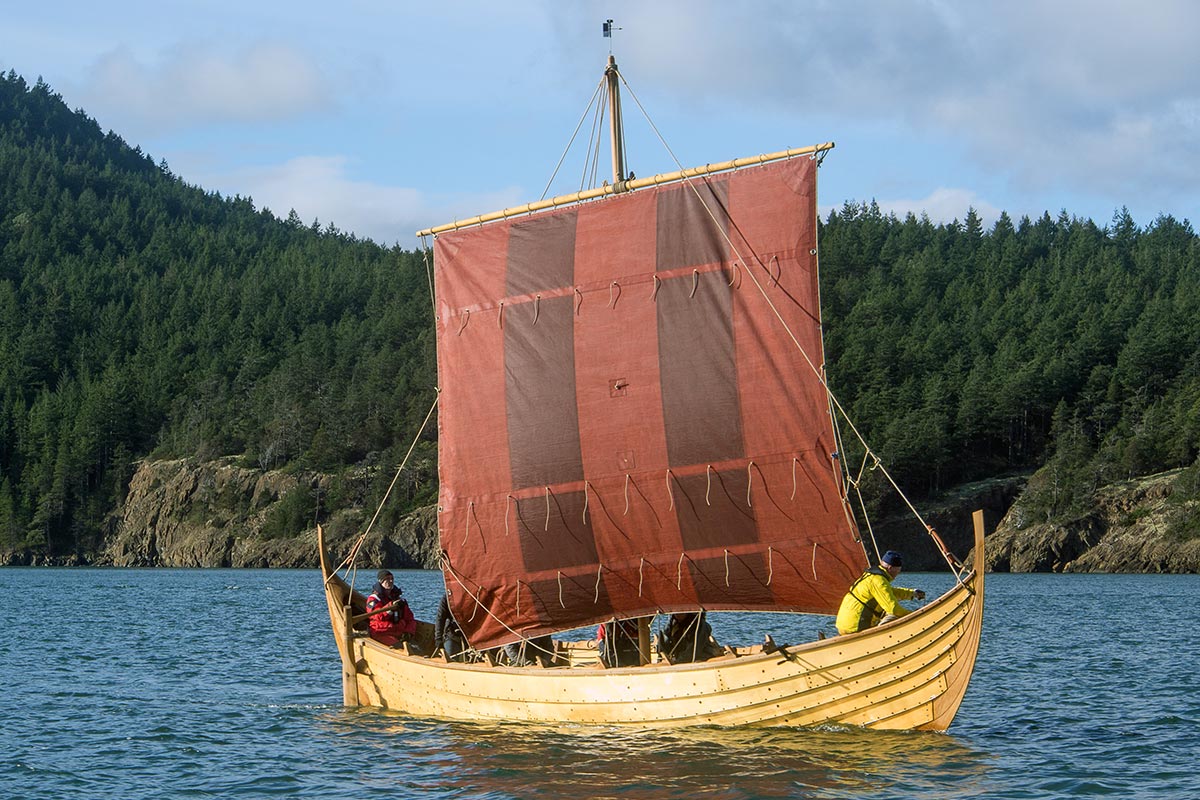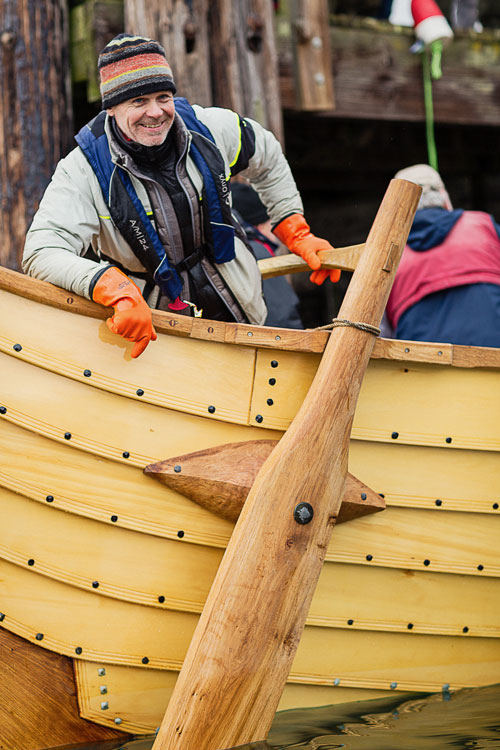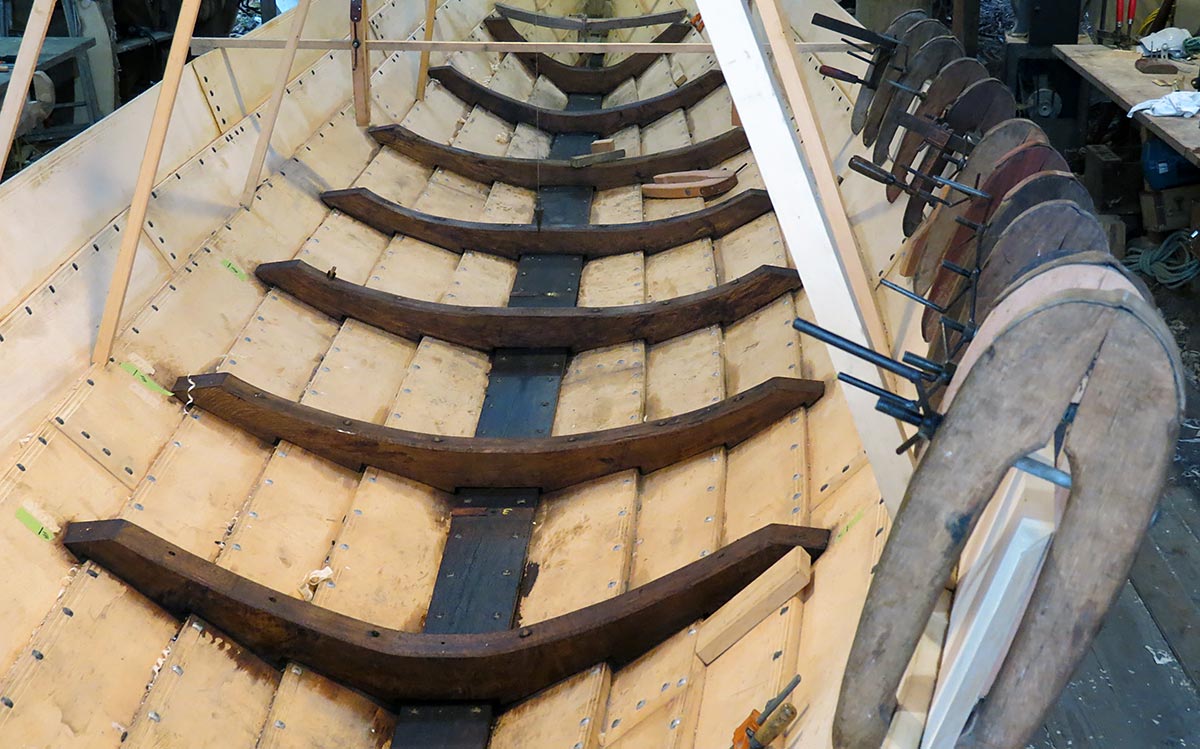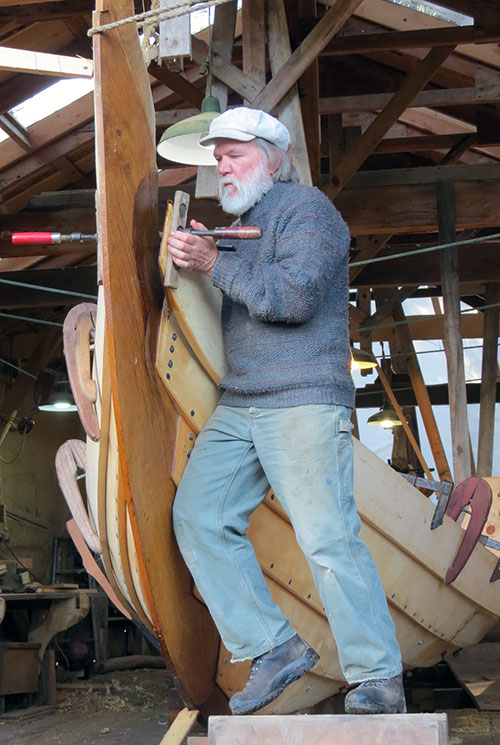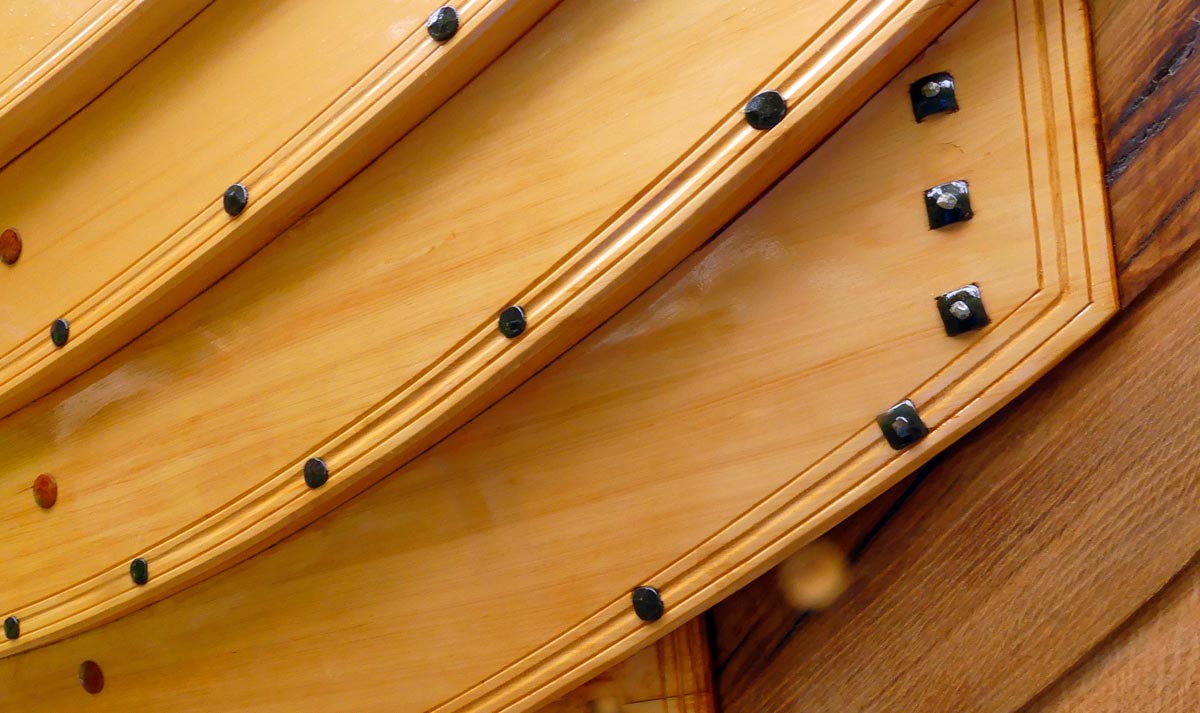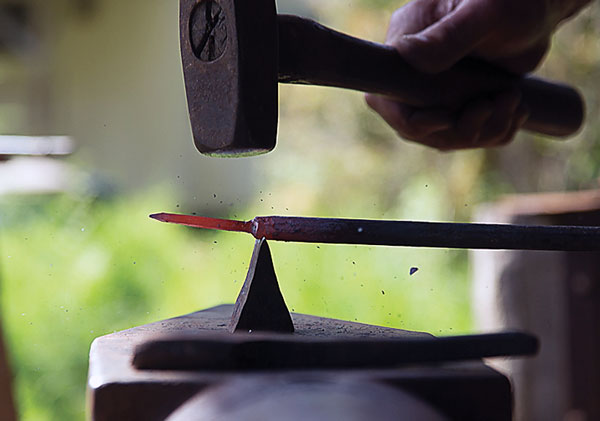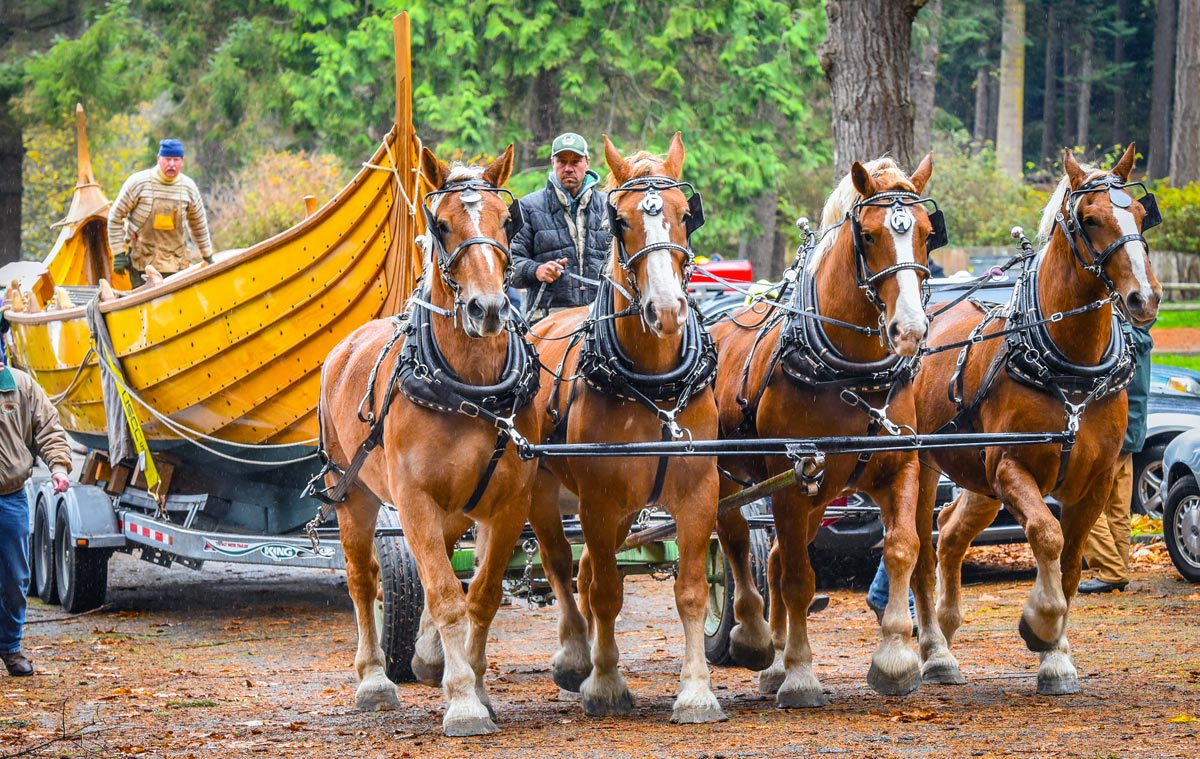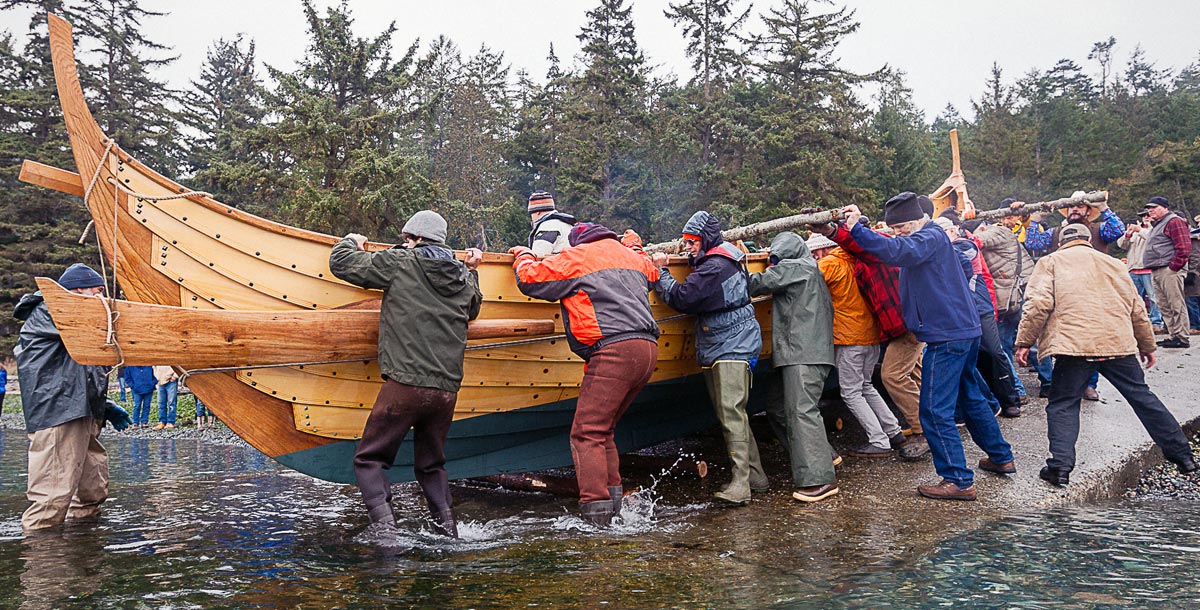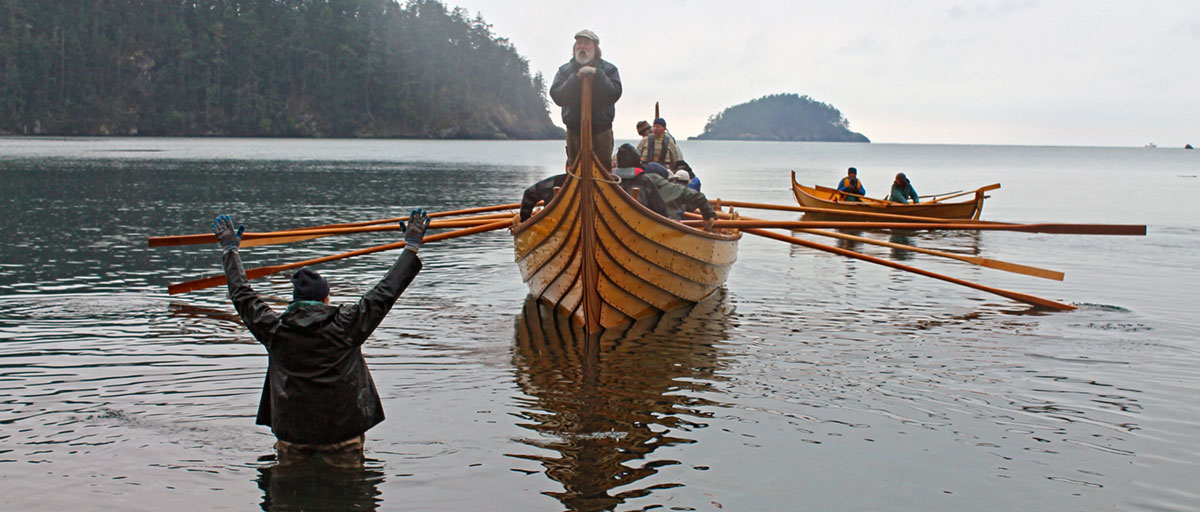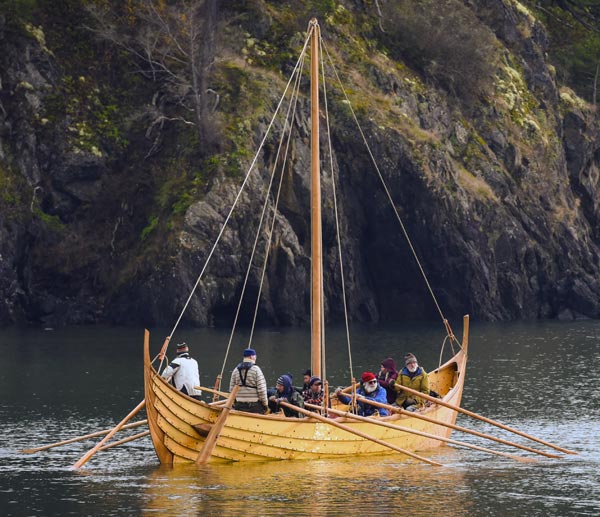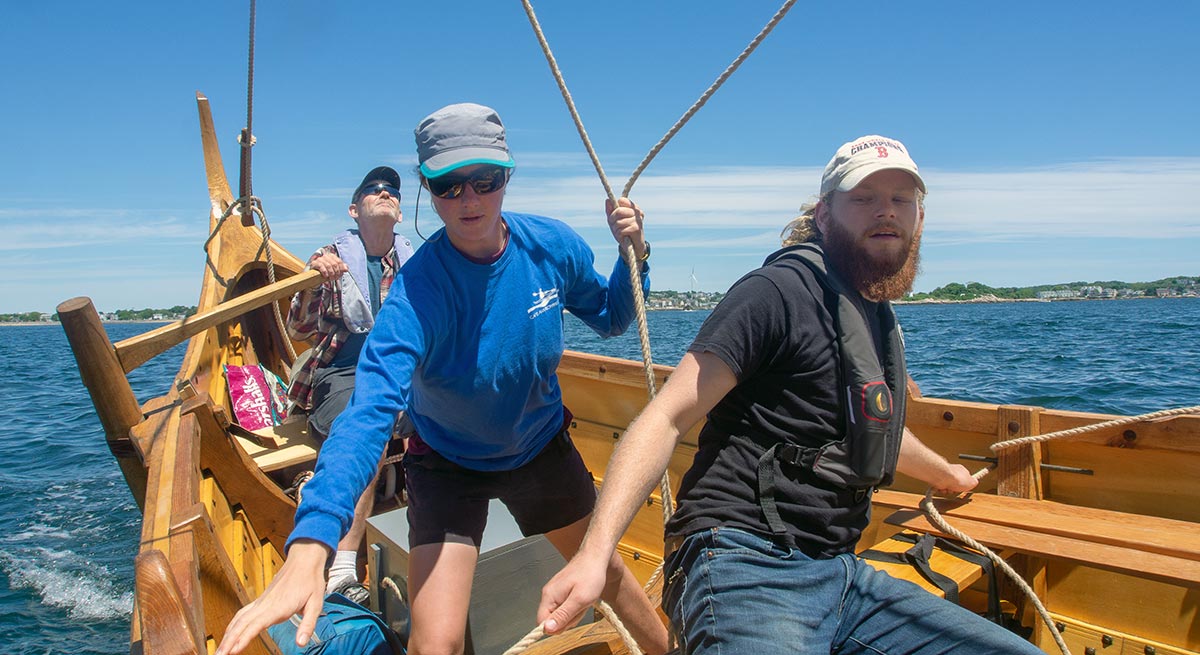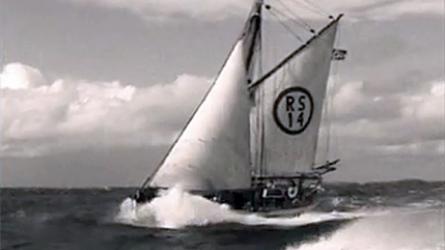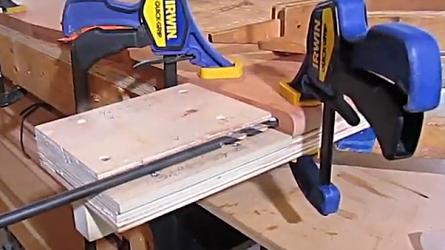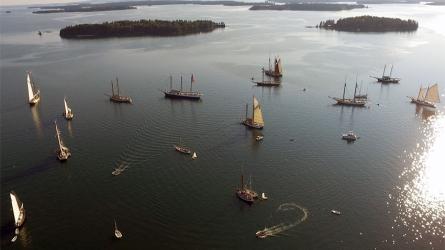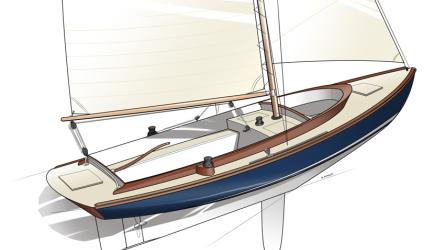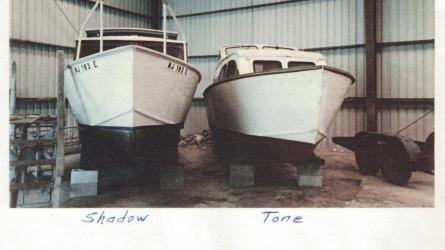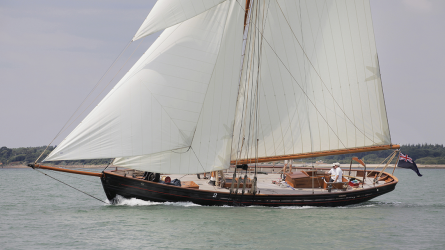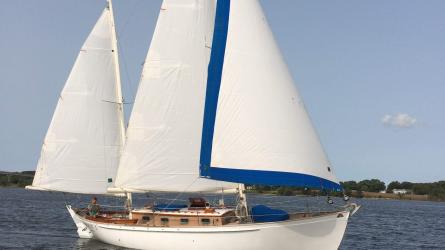F. Jay Smith
The Viking ship POLARIS is shown here soon after her 2017 launching in Washington State. Soon after this, she was trucked across the United States to Gloucester, Massachusetts, where she operates as a training vessel.
POLARIS shines honey gold, her Alaska yellow cedar planking reflecting in the sunlight. She is the newest, and definitely shiniest, of the very few Viking boats to ever arrive on New England shores within the last millennium. Built by F. Jay Smith and launched in Anacortes, Washington, in November 2017, then trucked to Essex, Massachusetts, for an East Coast launching in June 2018, the 36′8″ (11m) POLARIS is a slightly modified, United States Coast Guard–inspected version of SKULDELEV 6, one of six Viking-age ships excavated from the bottom of Roskilde Fjord, Denmark, in 1962. But rather than being used for fishing—as the original, similar sized, SKULDELEV 6 is believed to have been when it was built in about the year 1030—POLARIS is used primarily for team building, sail training, and providing summer visitors a unique experience on the water.
Thaddeus Hink
Owner Stuart Boyd, shown here moments after the launching of POLARIS, conceived the project as a new business venture and fresh career path.
After more than 30 years as a corporate electronics engineer and business manager, Stuart Boyd, 59, was laid off and uncertain about his next career path. Originally from Northern Ireland, and a longtime resident of Hamilton, Massachusetts, he considered moving back to Europe. While looking for a job in Denmark he stumbled into the Viking Ship Museum in the town of Roskilde and went rowing and sailing in one of its boats. He “immediately felt the community aboard as well as the impact of small groups working together to row and sail these amazing ships.”
He returned to the Boston area and half-jokingly told his career counselor that “he could always build a Viking ship.” The career counselor took Boyd’s idea seriously. She told him to write up two business plans— one about how to make startup collaborations more successful and another one about building a Viking boat and using it as a place for “people who worked in the same company, but hadn’t worked with each other closely, to have the opportunity to do so in the boat.” “Come back in three weeks and we’ll talk about them both,” the counselor told him.
“Guess which one I worked on the most? She could tell that all my energy and passion were behind the Viking boat plan,” Boyd said. He didn’t want to spend the rest of his career in an office, and so he refocused his energies on living according to a new credo—a healthy mix of “productivity, adventure, and learning new things.”
Already an active sailor with more than 40 years of recreational sailing and boating experience, including holding a 50-ton captain’s license, Boyd figured he was old enough to cast aside the advice of his father, who had pursued his sailing habit ahead of most other things and implored his son to not try to make a career through sailing.
Boyd thought extensively about how to bring some of the magic of Viking boats to New England and how to start a small business based around team building aboard a Viking ship. It was not an incongruous notion: in the year 985, the first Viking visitors to North America landed in a place they called Vinland, or “land of wild grapes.” Its precise location is the subject of scholarly debate, but there is evidence that the Vikings explored part of the region that would become New England. The vision of a Viking boat sailing off the north shore of Massachusetts thus became a focal point for Boyd.
True fortune arrived in June 2014 when Boyd learned that Smith (see WB No. 234), who specializes in building traditional Scandinavian small craft, would be demonstrating traditional skills at The WoodenBoat Show at Mystic Seaport. Following the talk, Boyd presented Smith a one-page photo montage of a Viking boat sailing near Crane Beach in Ipswich, Massachusetts, near where he lives, and he said, “They tell me you’re the guy who could build a Viking boat for me. Is that true?”
Smith said, “If you really want to build a Viking boat, we need to go to Roskilde.”
F. Jay Smith
The floor timbers were fitted to the partially planked hull. The remainder of the planking was shaped, in Nordic fashion, with the aid of prop sticks whose upper ends are braced overhead and whose lower ends hold plank edges in position.
Boyd was pleased with that answer, and the men met for the second time in Roskilde in early August 2014. “One of us didn’t have a cell phone. I think you know which one that is,” Boyd said, “but we did find each other.” Their intention was to meet with the builders and sailors at the museum and pick the right design. Boyd knew the boat needed to accommodate 12 to 14 people, and it had to be capable of handling New England coastal waters. “I also felt like if I was going to build something, I needed to build a flagship—a true Viking ship.”
Susan Wood
Smith, seen here at work on POLARIS’s planking, has built Nordic-style lapstrake boats for more than 35 years; he is a leading expert on the type in the United States. His business, Aspøya Boats in Anacortes, Washington, is named for the place of his first apprenticeship in Norway.
KRAKA FYR fit the design brief. Part of the museum’s fleet of more than 40 boats, it is a copy of SKULDELEV 6 built at the museum in 1998. It takes visitors rowing and sailing almost daily. The museum provided plans and shared details of how they make their fleet work as a business. Boyd came away from the week in Roskilde with a newfound confidence in his vision.
There are differences between KRAKA FYR and POLARIS. KRAKA FYR closely followed the archaeological evidence of SKULDELEV 6, which was designed with a low sheer for hauling fishing nets over the side. When SKULDELEV 6 was converted into a cargo boat toward the end of its career, a strake was added to each side to increase the sheer height. Boyd wanted the additional freeboard provided by an extra plank, but not the aesthetics of the cargo ship. Once back in Massachusetts, he worked with the naval architect Jim Taylor of Marblehead to modify SKULDELEV 6 to his tastes. Taylor drew a sheerline somewhere between that of the original SKULDELEV 6 and the modified cargo-boat version.
Boyd presented Taylor’s drawings to the Coast Guard to start the inspection process. “The relationship with the Coast Guard began a little rocky,” Smith said. “They were unfamiliar with these boats so were a little doubtful in the beginning; they needed to test us a bit. There isn’t a Viking ship category in the American Bureau of Shipping Regulations, so Boyd needed to provide the Coast Guard with alternative evidence to show the boat was structurally sound. “The way the Coast Guard is structured, there is a Washington, D.C., central engineering group, then there are regional offices with their own inspectors. The designers in D.C. and the inspectors in Washington state and in Boston all needed to be involved in the decision-making. It became a large management process to keep it all moving,” Boyd said.
By summer 2015, Smith had laid the keel and needed to decide on a planking schedule. He had to scarf the planks to achieve the necessary sweep of the strakes, but that needed Coast Guard approval. The Coast Guard specifies a 12:1 glued scarf. But a Viking boat, Boyd said, “needs to stay flexible.” He and Smith were concerned that glued plank scarfs would make for harder, less flexible joints than those using the Viking-age technique. The traditional way to scarf planks was to use a riveted joint with a 4:1 slope (i.e., for a 1″-thick plank, there’s a 4″-long slope); this allows flexibility, but is durable. “We had to get several testimonials from experts in Roskilde and Norway to show the Coast Guard. Once we did, they agreed to it,” Boyd said.
The rivets also needed Coast Guard approval. Each one was individually made of very low-carbon steel by a blacksmith in Washington. He found 1′-long, 5″-wide, ¾″-thick chain-links of wrought iron made in 1890 in Seattle, to be used in log booms during the time of the virgin timber harvest in Washington. “The chains probably came out in rods from Pittsburg, the steel capital,” Smith said. Each link yielded about 30 rivets. They are rose-headed, meaning they are faceted on four sides, making a pointed head on which the bucking iron rests while the rivets are peened over the roves. The head shape “also gives strength to the head,” Smith said. “The head is large enough to pull the planks together.” The four-cornered cupped roves on the inside “bite into the plank.”
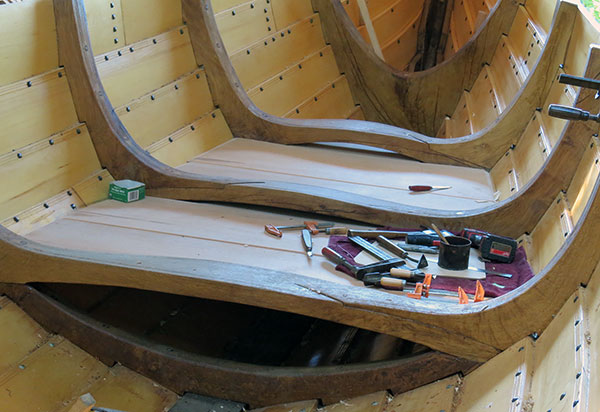
F. Jay Smith
A long, naturally grown crook serves as a portion of a combined beam and knee on one side of the boat; a shorter knee on the opposite side completes that structural member. The larger crooks alternate port and starboard, giving the boat a balanced strength, and a half-diamond mortise joint locks the two timbers together. Smith, who replicated this idea from 1,000 years ago, said the original shipwright “was some kind of artist.”
Boyd’s background as an engineer helped move the project along with the Coast Guard. He taught himself how to use a web-based CAD program called OnShape so he could make 3D renderings of the boat for periodic reports to the Coast Guard. When the Coast Guard insisted on a collision bulkhead, for example, Boyd made a CAD drawing for approval. In the renderings, he “could apply various parameters, such as typing in ‘oak,’ and it would report how heavy the piece was,” Boyd said. “It was helpful for the Coast Guard to see those drawings and not bother Jay.”
It was important to Smith that he build as true to the Viking tradition as possible within the Coast Guard requirements. “We wanted iron rivets, square roves, trunnels [wedged wooden pegs; aka tree nails] for fastening the frames, natural grown crooks for the frames, softwood for the planking, hardwood for the backbone, stem, and stern, and to not import anything,” Smith said. He selected the best possible local materials for the job: Oregon white oak, or Garry oak, for the keel, stem, stern, and frames; Alaska yellow cedar planking from the North Cascades; Pacific yew for the trunnels; black locust for the oarlocks, gunwales, and trunnel wedges; and Douglas-fir for the floorboards. Yew is extremely flexible, and locust is one of the most rot-resistant North American hardwoods. “The boat is going to flex all its life under sail, so the trunnels need to flex and return, too, but not fracture,” Smith said. The wedges go about 3″–4″ deep, two-thirds the length of the trunnel. For increased strength, the trunnels and wedges are installed with their respective grains running perpendicular to each other.
POLARIS’s Alaska yellow cedar planking is from 500- to 800-year-old trees, which is nearly as old as those cut to build the original SKULDELEV 6. (Through taking core samples of SKULDELEV 6′s Scots pine planks and comparing them with the tree ring count of the stave churches found in the Sognefjord region of Norway, it was deduced that the ship was built between 1030 and 1035.)
Smith has made strong relationships with sawyers throughout the Pacific Northwest over the past 30 years, and this allowed him to be selective in locating fine timber for this boat. “Some of the material, grown at above 4,500′ elevation in the North Cascades, had as many as 40 years of growth in one short inch,” he said. “There is nothing more exhilarating for a boatbuilder than to be at the mill and see the first slice come off, and the second, and then to discover it’s absolutely, perfectly clear. The sawyer would shut down the mill after a few slices, and call out, ‘It’s the money log!’” For the white-oak gunwales, keel, and frames, he had to “sweet-talk” his way into a neighbor’s 1,300-acre oak forest. He knew the shapes in his mind and just needed to start harvesting.
Bob Jepperson
The carved lines and cove on the plank edges form Smith’s signature detail.
The Douglas-fir floorboards are from trees felled and then left behind in about 1910. “They’d been in the woods for 100 years. All the bark was gone, all the sapwood was gone, but the pitch had kept the bugs out,” Smith said. A single slab spans the width of the boat.
The mast was “heaven-sent,” Smith said. His sawyer friend told him he had a 38′, straight Sitka spruce tree available. Smith told the sawyer he needed only 27′. So the sawyer found a buyer for the remaining 11′ piece. Smith recalls shaping that wood: “It was almost spiritual. Such perfect grain, full length, tight, flawless stuff...worked with a hand plane and got 26′ shavings.”
Mark Thayer
The rose-headed rivets were hand-forged on site from chain links of wrought iron that were made in 1890.
The oak keel is carved to be T-shaped in crosssection, so the garboards can be riveted to it rather than set in a rabbet and spiked. “The garboard can be a troublesome seam, so riveting helps to eliminate that,” Smith said, noting that “spikes lose their holding power after being worked by the boat.” The hood ends are similarly riveted to the sculpted stem and sternpost.
Molds were used to establish the boat’s beam and to line-off the planking, but Smith said they served as “guidelines.” He removed half of them during planking in order to reduce clutter; he planked the hull to just above the waterline, fitted the frames, and then completed the planking.
There is a plank at the waterline that’s thicker than the others. It is called a meginhufr. The garboard is 1¼″(32mm) thick, the standard planks are 1″ (26mm) thick, but the robust meginhufr is 1¾″ (45mm) thick. It acts as a secondary keel when the boat is heeled over, and as a longitudinal stiffener. Smith added a doubleline groove detail on the lower edge of each plank outboard, and the upper edge inboard. This, in the Nordic boatbuilding tradition, is his “builder’s signature.”
The keel, frames, stem, and sternposts are all finished with a mixture of pine tar, boiled linseed oil, and turpentine, which is applied hot as soon as the piece is ready to be installed in the boat. This treatment prevents the wood from drying too quickly. “There is still some movement in the boat as it dries,” Smith said, “but you can minimize it with the pine-tar-and-linseedoil application.” The cedar was air-dried for a few months before planking.
Bob Jepperson
The completed POLARIS was hauled by horses from Smith’s shop to the water’s edge for launching. Later, she was shrinkwrapped for the long haul by truck to Gloucester.
The planks are finished with Le Tonkinois, an oilbased coating developed by the French navy for treating brightwork in Southeast Asia. “Its goes on heavy and easily and is not as temperamental as varnish. Four coats looks about the same as seven coats of varnish. There are no petroleum distillates, so it’s more friendly to people and the environment,” Smith said.
Viking-age boats normally have bowling ball-sized beach stones as ballast; the stones sit in the bilge, just aft of the mast. The Coast Guard didn’t like the idea of loose stones in the bilge, so Boyd and Smith designed a lead shoe that fits over the outer keel; this change required minimal alteration to the hull profile. Smith built a wooden pattern around the keel, and a foundry in Seattle cast the ballast in two sections weighing 660 lbs (300 kg) each. Smith bolted and spiked these into place.
Thaddeus Hink
POLARIS heads for the water. Viking ships, says Smith, are “delightful to build, and they have all the essential elements of simplicity, minimalism, beauty, function.”
Smith served a 16-month boatbuilding apprenticeship in Norway while in his late 20s, and served a second apprenticeship in his early 30s in the Faroe Islands for eight months. He recalls that in the Faroes, when a boat is launched, it is rowed in a circle three times in the direction of the sun, and he continues this ritual with all of the boats he builds, including POLARIS when he launched her into Bowman Bay in Anacortes on November 4, 2017. “We are the keepers of these traditions,” he said, “and if we drop them, then the next generation won’t know.”
Martin Lian
POLARIS floats for the first time on November 4, 2017, on Bowman Bay, Washington.
Bob Jefferson
The distance between a Viking ship’s oarlocks determines the distance between thwarts, and for every thwart there is a frame. The space between frames is called a “room.” The Coast Guard certification process required no extra frames, so in this regard POLARIS is identical to her predecessor, SKULDELEV 6, which was built in about the year 1030.
I sailed POLARIS for the first time in December 2017 in Anacortes. The builders, riggers, and sailmakers all gathered on the dock, full of nervous energy. Once we finally raised the sail and saw that nothing immediately broke, a huge sigh of relief, and then joy, rippled through the group.
In spring 2018, the boat was trucked across country for another launching ceremony on June 2 at the Essex Shipbuilding Museum in Massachusetts. She proceeded to sail from nearby Gloucester through the summer and fall of that year.
The goal for the first season was to become familiar with how the boat maneuvered rather than filling the thwarts with paying participants. She’s been “parallel parked” now a hundred times in the tight slip between rocks, dinghies, and schooners at Maritime Gloucester, a heritage center on the city’s historic waterfront. And she has been successfully stopped for a mock crewoverboard drill under sail. Of the visiting crews who’ve come aboard to experience POLARIS, Boyd has heard, “Do I get to row?” and, “Oh, you make them row?” His goal is to attract more of the “Do I get to row?” people.
For the current season, Boyd is using POLARIS to help people—from corporations to school groups—to develop and hone their leadership skills. He believes the “immersive experience” of the “unusual physical and social environment” of a Viking ship is ideal for this work. “The boat brought together a great group of people who became my friends,” Boyd said. Indeed, building POLARIS changed his life.
And for Smith, the construction of POLARIS “was exhilarating. It’s like completing a doctoral thesis in Nordic lapstrake.” 
Karen Angelli
Boyd, shown here at the helm on an outing out of Gloucester, believes that the “immersive experience” of the “unusual physical and social environment” of POLARIS is ideal for developing team-building and leadership skills.
Arista Holden, occasional captain of POLARIS, is also a member of WoodenBoat School’s waterfront staff, trains Team USA for Atlantic Challenge, and runs international sailing tours in traditional boats. Learn more at maritimeworldexpeditions.com.
F. Jay Smith is completing a new 56′ Viking boat—a larger-than-POLARIS version of SKULDELEV 6 to be called VALKYRIE. Stuart Boyd is working as an advisor on the project, making working drawings for the Coast Guard certification process.
Half-day, full-day, and multi-day trips aboard POLARIS can be arranged at www.norsvald.com.
